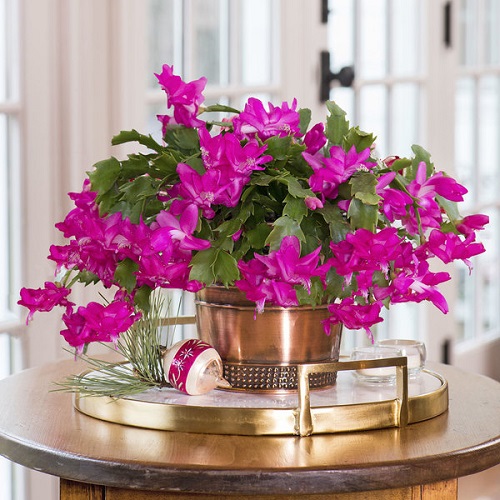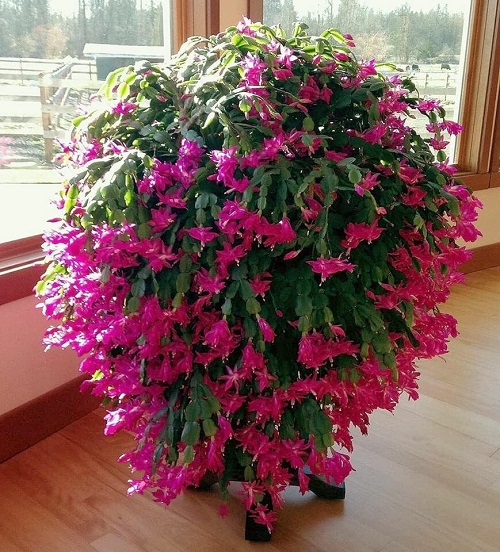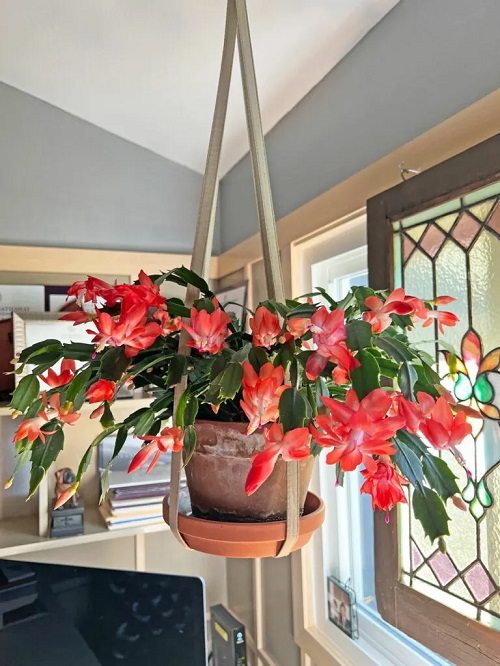Keep your Schlumbergera flowering and green with these 8 Christmas Cactus Care Tips, which will help you flaunt it in style!

With our detailed guide on Christmas Cactus Care Tips, you’ll learn the secrets to keeping this tropical succulent healthy and blooming. Let’s get started!
Widen Your Pretty Houseplant Collection With These Cactus with Pink Flowers Here
Christmas Cactus Care Tips

1. Select the Right Sized Container
Choosing the right container for a Christmas Cactus is like picking out a comfortable pair of shoes. It should have enough room for the roots to breathe but not so much space that the soil stays wet for too long. A pot just an inch or two wider than the plant’s root ball is ideal. Don’t forget the drainage holes; they’ll ensure excess water has a way to escape, preventing the dreaded root rot.
You may go for a ceramic, plastic, or terracotta pot, but whatever you choose, enough drainage holes are non-negotiable. Terracotta pots are particularly a great fit as they are porous and help evaporate excess moisture, reducing the risk of root rot even more.
2. Maintain the Right Temperature
Being from the Brazillian rainforests, Christmas Cactus prefers a specific warm temperature range and humidity conditions, anywhere between 60-80°F (15-27°C)—a typical room temperature. During the flowering phase, though, it prefers a slight chill at night, around 50-55°F (10-13°C). This drop in temperature is like a signal that tells the plant it’s time to start setting buds.
3. Keep the Air Humid
The Christmas Cactus prefers a moderate humidity level between 50-60%, which basically mirrors the slightly moist air of its native tropical forests. In many homes, especially those with central heating or air conditioning, the indoor air can be quite dry, falling below this ideal range.
In such a case, use a humidifier or place a water-filled tray with pebbles beneath the pot to increase humidity. However, ensure the pot isn’t sitting directly in water, or that would do more harm than good.
4. Take Care of the Sunlight
Sunlight for a Christmas Cactus is all about balance. Direct, harsh sunlight is a big NO, as it can burn the leaves, but too little light and your cactus might not bloom.
Place it at a spot with 2-4 hours of morning light exposure, and avoid the afternoon overhead heat. East- or north-facing windows can be the plant’s happy place due to their softer light. Take care of the seasonal adjustments and shift the plant as per its care requirements.
5. Hit the Right Moisture Balance
Proper watering is key to a healthy Christmas cactus, especially during the holiday season. Overwatered plants will fail to bloom and might show wilted leaves due to root rot as well. The best bet is to water only when the top inch of soil is dry, using room temperature water to avoid shocking the plant.
Do not leave the medium soaked in water and let it dry out a bit in intervals. In the winter, post-blooming, reduce the watering frequency as the cactus enters a resting phase during this time.
6. Prepare the Right Potting Blend
Your Christmas Cactus loves a potting mix that’s like a nutrient-rich, breathable bed. A mix designed for cacti or succulents works great because it allows for quick drainage and prevents water from lingering too long. You can create your own blend by mixing equal parts of potting soil, perlite, and peat moss.
7. Fertilize Your Christmas Cactus Right
Begin fertilizing in early spring with a half-strength balanced liquid fertilizer—preferably 20-20-20 or 20-10-20 blend. This is when your Christmas Cactus ends its inactive phase and starts new growth. Apply it once a month through summer to support its growth.
As the days start to shorten, it’s time to reduce it to one-quarter strength and eventually stop fertilizing in the winter. This gradual reduction in feeding helps transition the plant into its bloom cycle. Ceaze fertilization by late fall to promote its flowering during the holiday season.
8. Prune It to Boost Growth
The best time to prune Christmas Cactus is after it finishes blooming, typically in late winter or early spring. Start by removing any dead or weak segments to encourage new growth. Use your fingers to gently twist off the segments, or employ clean, sharp scissors for precision.
When pruning, aim to cut back each stem by about one-third, focusing on sections that appear overgrown or leggy.
Christmas Cactus Flowering Secrets

Inducing a Christmas Cactus to flower requires maintaining certain specific conditions. Here’s how you can create one:
- Reduce Watering to Stress the Plant: Beginning in late August or September, gradually reduce watering to stress the plant slightly, which encourages blooming. However, avoid letting the soil become completely dry.
- Reduce the Light Exposure: Starting in mid-fall from October to November, reduce the amount of light the cactus receives to about 8 hours per day. Place it in a room that naturally gets dark as the sun sets, or cover it with a box or cloth to create a dark environment.
- Temperature Control: Maintain a consistent temperature of about 60-68°F (15-20°C) during the day from October to December, with a slight drop at night, but not below 55°F (13°C). This mimics the natural temperature drop in its native habitat during the bloom-triggering season.
- Avoid Moving the Plant: Once buds begin to form, keep the cactus in the same location without rotating or moving it, as this can cause bud drop.
Troubleshooting Christmas Cactus Problems

Troubleshooting common problems with Christmas Cacti is key to keeping them healthy, especially during the festive season. Here are specific tips:
- Drooping or Wilting: This often indicates overwatering or underwatering. Check the soil; if it’s soggy, reduce watering and ensure good drainage. If dry, water the plant thoroughly.
- Yellowing Leaves: Usually a sign of too much direct sunlight or overwatering. Move the cactus to a location with bright, indirect light and adjust your watering schedule.
- Leaf Segments Falling Off: Often caused by sudden temperature changes or overwatering. Keep the plant in a stable environment and follow a consistent watering routine.
- Root Rot: A serious issue usually resulting from overwatering or poor drainage. If suspected, repot the plant in fresh, well-draining soil and trim away any rotten roots. Overly damp conditions can lead to fungal issues. Prevent this by avoiding overwatering and ensuring good air circulation around the plant.
- Pest Problems: Spider mites and mealybugs can occasionally trouble Christmas Cacti. Treat infestations with a gentle insecticidal soap or neem oil, taking care to follow the product instructions.
- Bud Drop: This can occur due to overwatering, lack of humidity, or a sudden change in temperature or light. Keep environmental factors consistent, especially when buds are forming.






